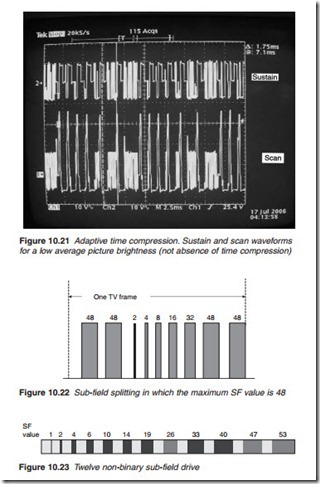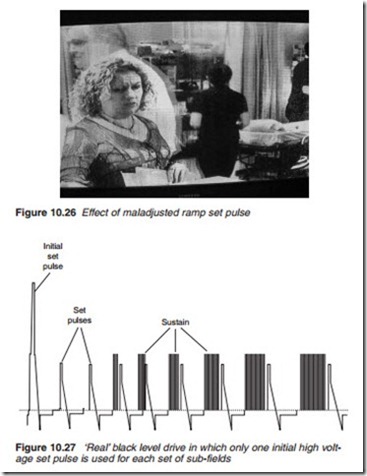Dynamic brightness control
As started earlier one of the major drawbacks of early plasma screens has been its low level of brightness compared with a CRT equivalent. Dynamic brightness control which Panasonic calls Adaptive Brightness Intensifier
(AI) and Pioneer calls i-CLEAR attempts to rectify this. The average picture level, APL is used to adjust the number of SFs. The standard number is 11 for normal brightness; it is reduced to 10 for dark scenes (low APL) and increased to 12 for bright scenes (high APL). The use of a larger number of SFs allows for finer weighting distribution and hence increased greyscale levels which improve the picture contrast range. In darker images, reduced number of SFs provides more time for the discharge period which improves peak brightness making dark scenes more visible. The reduction in greyscale levels in a low luminance picture is not discernable by the human eye. Furthermore, variable SF coding helps to maintain power consumption within small variations which improves efficiency and reduces cooling requirements making it possible to dispense with the use of cooling fans.
Other techniques employed by various manufacturers to improve panel brightness and contrast include box-shaped and deep cell structures to enlarge the effective phosphor surface and the use of ‘direct colour filter’ to reduce ambient light reflection. Ambient light reflection may also be reduced using ‘black stripes’ applied to the front glass, a technique devel- oped by Pioneer.
Black level drive
One of the most important factors in the perception of natural images on a television screen is the contrast. Contrast is the difference between black level and maximum brightness. It may be improved by either increasing peak brightness or decreasing the black level. Light emission in a plasma panel is produced whenever a discharge takes place. While plasma dis- charges take place mainly during the sustain period, there are other small discharges that take place outside the sustain phase. The most significant of these is that caused by the high-voltage high-rising initialisation pulse at the start of each set–address–sustain cycle. The effect of this discharge is a fairly bright radiation known as ‘priming light’ emanating from the phosphor which makes the blacks slightly grey making it difficult to reproduce dark scenes. As this is repeated for each SF, some ten to twelve times per frame, the accumulated effect is to lift the black level and decrease the contrast ratio. The effect of the set pulse may be reduced by employing the ramp-shaped pulse shown in Figure 10.24. When a ramp is applied to the sustain-scan electrodes, a very weak discharge occurs for a longer period generating fewer UV rays and hence less phosphor radiation.
The shape of the set pulse in terms of its gradients and voltage levels have to be precisely set according to the manufacturer’s specifications to within very tight limits. One such specification is illustrated in Figure 10.25.
The shape of the ramp pulse may be adjusted with two or more vari- able pots as indicated by the manufacturer. Slight changes in the shape
of the ramp set pulse would result in colour noise on part or the entire displayed image depending on the type and severity of the change. A typ- ical symptom of a badly adjusted set ramp pulse is shown in Figure 10.26.
Another technique called ‘Real Black drive’ used by some manufacturers dispenses with the use of large initialisation pulse at the start of all SF except the first one. The first SF starts with the normal high-amplitude ini- tialisation pulse while the remaining SFs use smaller initialisation pulses as shown in Figure 10.27.


